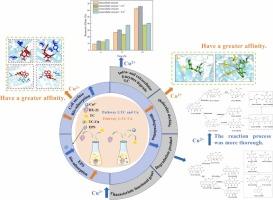铜离子对假单胞菌DX-21增强四环素去除的协同作用:机制研究
IF 11.3
1区 环境科学与生态学
Q1 ENGINEERING, ENVIRONMENTAL
引用次数: 0
摘要
四环素在废水中的广泛存在对生态平衡造成了严重威胁。迄今为止,筛选的菌株降解TC的能力相对有限。如何提高现有菌株的代谢能力,有效地去除TC是一个亟待解决的问题。在这里,添加Cu2+来改善菌株DX-21的代谢。Cu2+浓度为0.5 mg/L时,TC去除率由对照组的0.309 mg/(L·h)提高到0.343 mg/(L·h)。Cu2+增加了细胞外聚合物质(EPS)的分泌,提高了细胞内和细胞外酶的活性。当TC- cu配合物存在时,TC的降解率提高。此外,Cu2+使DX-21降解过程中产生的副产物种类减少了2种,反应过程效率提高,降解产物的生物效应没有明显变化。此外,通过转录组分析和分子对接模拟验证了Cu2+和TC- cu配合物增加DX-21去除TC的能力。因此,本研究加深了对金属离子在微生物去除TC中的作用的认识,揭示了通过添加金属离子进行生物增强以增强废水中抗生素去除的潜力。本文章由计算机程序翻译,如有差异,请以英文原文为准。

Synergistic effect of copper ions on Pseudomonas sp. DX-21 for enhanced tetracycline removal: A mechanistic study
The widespread occurrence of tetracycline (TC) in wastewater poses a significant threat to ecological balance. Thus far, the ability of the strains screened to degrade TC has been relatively limited. How to enhance the metabolic capacity of existing strains to efficiently remove TC remains an urgent issue to be addressed. Here, Cu2+ was added to improve the metabolism of strain DX-21. The TC removal rate increased from 0.309 mg/(L·h) in the control to 0.343 mg/(L·h) at a Cu2+ concentration of 0.5 mg/L. Cu2+ increased extracellular polymeric substance (EPS) secretion and improved intracellular and extracellular enzyme activities. The degradation rate of TC increased when TC-Cu complexes were present. Moreover, Cu2+ led to a decrease of two with respect to the types of byproducts produced during DX-21 degradation, the reaction process was more efficient, and there was no significant change in the biological effects of the degradation products. Moreover, the ability of the Cu2+ and TC-Cu complexes to increase the removal of TC by DX-21 was verified via transcriptome analysis and molecular docking simulations. Therefore, this study deepens the understanding of the role played by metal ions in the microbial removal of TC and reveals the potential of bioaugmentation to enhance antibiotic removal in wastewater through the addition of metal ions.
求助全文
通过发布文献求助,成功后即可免费获取论文全文。
去求助
来源期刊

Journal of Hazardous Materials
工程技术-工程:环境
CiteScore
25.40
自引率
5.90%
发文量
3059
审稿时长
58 days
期刊介绍:
The Journal of Hazardous Materials serves as a global platform for promoting cutting-edge research in the field of Environmental Science and Engineering. Our publication features a wide range of articles, including full-length research papers, review articles, and perspectives, with the aim of enhancing our understanding of the dangers and risks associated with various materials concerning public health and the environment. It is important to note that the term "environmental contaminants" refers specifically to substances that pose hazardous effects through contamination, while excluding those that do not have such impacts on the environment or human health. Moreover, we emphasize the distinction between wastes and hazardous materials in order to provide further clarity on the scope of the journal. We have a keen interest in exploring specific compounds and microbial agents that have adverse effects on the environment.
 求助内容:
求助内容: 应助结果提醒方式:
应助结果提醒方式:


